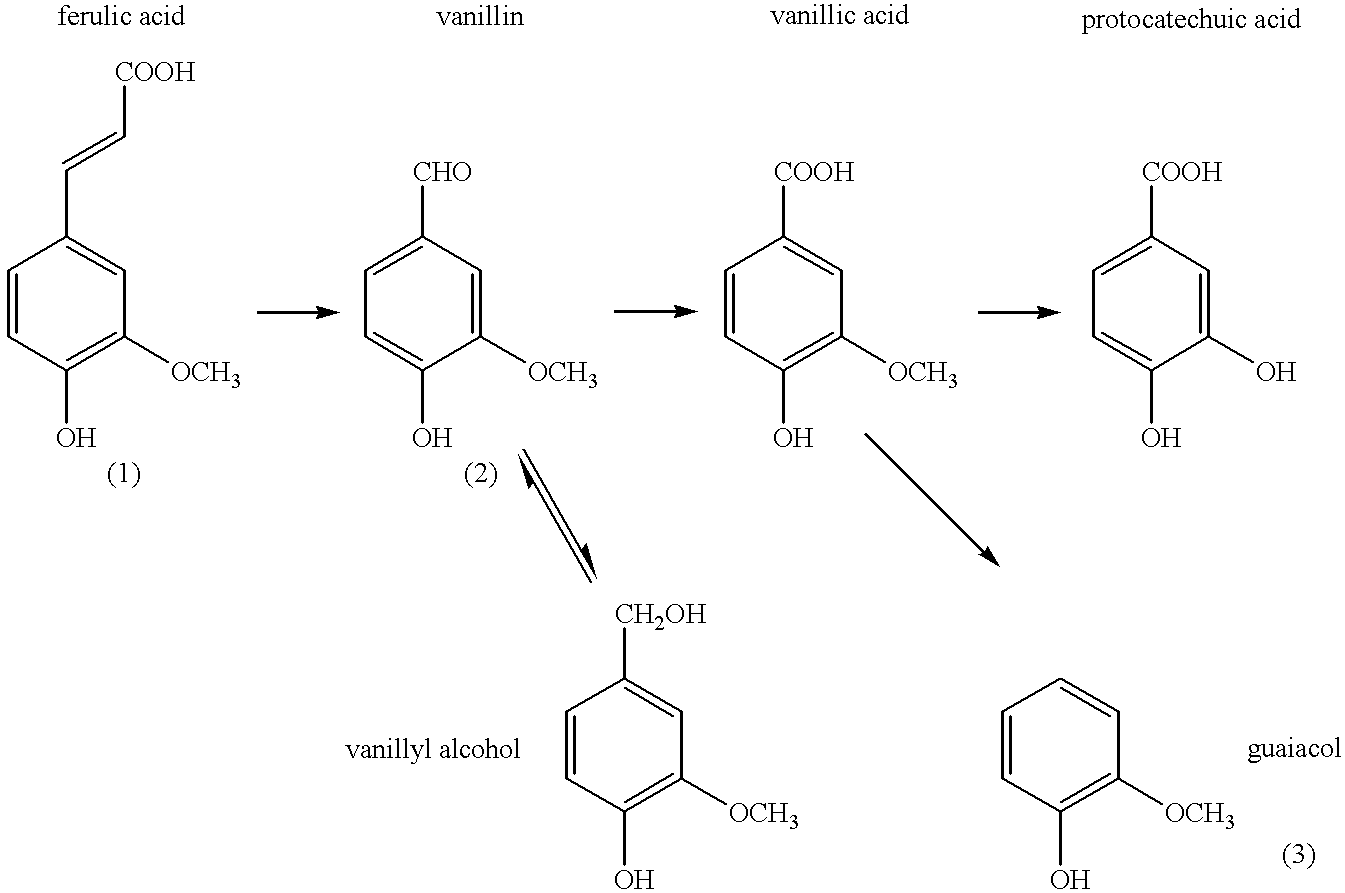Microbiological process for producing vanillin
a microbiological process and vanillin technology, applied in the field of microbiological process for producing vanillin, can solve the problems of low transformation yield, low commercially attractive volumetric yield, and unreported volumetric yield
- Summary
- Abstract
- Description
- Claims
- Application Information
AI Technical Summary
Benefits of technology
Problems solved by technology
Method used
Image
Examples
example 1
250 mL shake flasks containing 50 mL of the following medium were prepared: 103 gL.sup.-1 sucrose, 4 gL.sup.-1 Na.sub.2 HPO.sub.4, 1 gL.sup.-1 KH.sub.2 PO.sub.4, 1 gL.sup.-1 yeast extract, 0.2 gL.sup.-1 NaCl, 0.2 gL.sup.-1 MgSO.sub.4 and 0.05 gL.sup.-1 CaCl.sub.2. The pH was adjusted to 7.2 using NaOH. A shake flask was inoculated with 2 mL of reculture of Streptomyces setonii ATCC 39116 and cultivated at 37.degree. C., 190 rpm or 16 hours. At the end of the growth phase 0.3 g ferulic acid (purchased from Aldrich, cat. no. 12.870-8, 99%) was added to the culture. For this purpose a 10% w / w solution of the acid substrate in 0.5 M NaOH (final pH of the solution was approximately 7.2) was previously prepared and sterile-filtered. The flask was incubated again at 37.degree. C., 190 rpm. After 31.5 hours of biotransformation (incubation) a vanillin concentration of 3.10 gL.sup.-1 (HPLC) was reached. A molecular yield of 66 mol % was calculated.
example 2
A 250 mL shake flask was prepared and incubated as in Example 1. After a 16 hours growth phase 0.6 g ferulic acid (as a 10% w / w solution in 0.5 M NaOH) was added to the culture. The flask was incubated again at 37.degree. C. and 190 rpm. After 78 hours of biotransformation (incubation) a vanillin concentration of 5.94 gL.sup.-1 (HPLC) was reached, corresponding to a yield of 63 mol %.
example 3
A 250 mL shake flask was prepared and incubated as in Example 1. After a 18 hours growth phase 0.3 g ferulic acid (as a 10% w / w solution in 0.5 M NaOH) was added to the culture. The flask was incubated again at 37.degree. C. and 190 rpm. After 28 hours a second feed of 0.3 g ferulic acid followed. At the end of the incubation (58 hours) a vanillin concentration of 6.41 gL.sup.-1 was reached, corresponding to a yield of 68 mol %.
PUM
 Login to View More
Login to View More Abstract
Description
Claims
Application Information
 Login to View More
Login to View More - R&D
- Intellectual Property
- Life Sciences
- Materials
- Tech Scout
- Unparalleled Data Quality
- Higher Quality Content
- 60% Fewer Hallucinations
Browse by: Latest US Patents, China's latest patents, Technical Efficacy Thesaurus, Application Domain, Technology Topic, Popular Technical Reports.
© 2025 PatSnap. All rights reserved.Legal|Privacy policy|Modern Slavery Act Transparency Statement|Sitemap|About US| Contact US: help@patsnap.com


